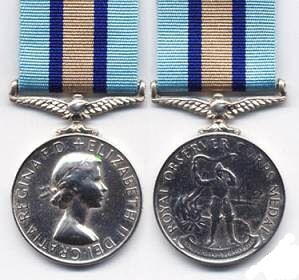The Royal Observer Corps (ROC) was a civil defence organisation intended for the visual detection, identification, tracking and reporting of aircraft over Great Britain. It operated in the United Kingdom between 29 October 1925 and 31 December 1995, when the Corps' civilian volunteers were stood down. Composed mainly of civilian spare-time volunteers, ROC personnel wore a Royal Air Force (RAF) style uniform and latterly came under the administrative control of RAF Strike Command and the operational control of the Home Office. Civilian volunteers were trained and administered by a small cadre of professional full-time officers under the command of the Commandant Royal Observer Corps; latterly a serving RAF Air Commodore.
 W
WAtomic Weapons Detection Recognition and Estimation of Yield known by the acronym AWDREY was a desk-mounted automatic detection instrument, located at 12 of the 25 Royal Observer Corps (ROC) controls, across the United Kingdom, during the Cold War. The instruments would have detected any nuclear explosions and indicated the estimated size in megatons.
 W
WBomb Power Indicator known by the acronym BPI was a detection instrument, located at the twenty five British Royal Observer Corps controls and nearly 1,500 ROC underground monitoring posts, across the United Kingdom, during the Cold War that would have detected any nuclear explosions and measured the peak-overpressure of the blast waves.
The Commandant of the Royal Observer Corps (CROC) was the Royal Air Force commander of the Royal Observer Corps. All the holders of the post were RAF officers in the rank of Air Commodore, initially retired reserve officers then Auxiliary officers and, since the end of World War II, serving officers. The ROC was a uniformed civilian branch initially under the control of the Air Defence of Great Britain organization, then Fighter Command and latterly Strike Command. The Royal Observer Corps existed from 1925 until it was stood down in 1995. Most of the commandants, with only three exceptions, were qualified RAF pilots, two being air navigators and the other a General Duties (Ground) Supply Branch officer. If a Royal Observer Corps officer had ever held the appointment, they would have held the rank of Observer Commodore.
 W
WThe Ground Zero Indicator, known by the acronym GZI was a specially designed shadowgraph instrument used by the British Royal Observer Corps during the Cold War to locate the Ground Zero of any nuclear explosion.
 W
WThe Royal Observer Corps (ROC) was a civil defence organisation operating in the United Kingdom between October 1925 and 31 December 1995, when the Corps' civilian volunteers were stood down.. Composed mainly of civilian spare-time volunteers, ROC personnel wore a Royal Air Force (RAF) style uniform and latterly came under the administrative control of RAF Strike Command and the operational control of the Home Office. Civilian volunteers were trained and administered by a small cadre of professional full-time officers under the command of the Commandant Royal Observer Corps; a serving RAF Air Commodore.
 W
WThe Post Plotting Instrument, or simply Post Instrument, was the standard optical sighting system used by the UK's Royal Observer Corps (ROC) to determine the location of aircraft. It was used during the period from the mid-1930s into the early 1950s, and was one of the main sources of daytime tracking information during World War II.
 W
WThe Royal Observer Corps Medal was instituted in 1950 by King George VI for long service by members of the Royal Observer Corps (ROC) in the United Kingdom. It was awarded until December 1995, when the ROC was stood down.
 W
WRoyal Observer Corps Monitoring Posts are underground structures all over the United Kingdom, constructed as a result of the Corps' nuclear reporting role and operated by volunteers during the Cold War between 1955 and 1991.
 W
WThe Royal Observer Corps Orlit Post is an observation post used by the Royal Observer Corps during the Cold War to recognise enemy aircraft. Many Orlit Posts can be found near ROC Monitoring Posts.
 W
WThe United Kingdom Warning and Monitoring Organisation (UKWMO) was a British civilian organisation operating to provide UK military and civilian authorities with data on nuclear explosions and forecasts of fallout across the country in the event of nuclear war.
 W
WRoyal Air Force Wrexham or more simply RAF Wrexham is a former Royal Air Force station at Borras, on the outskirts of Wrexham, Wales and east of the town centre.
 W
WThe York Cold War Bunker is a two-storey, semi-subterranean, Cold War bunker in the Holgate area of York, England, built in 1961 to monitor nuclear explosions and fallout in Yorkshire, in the event of nuclear war.